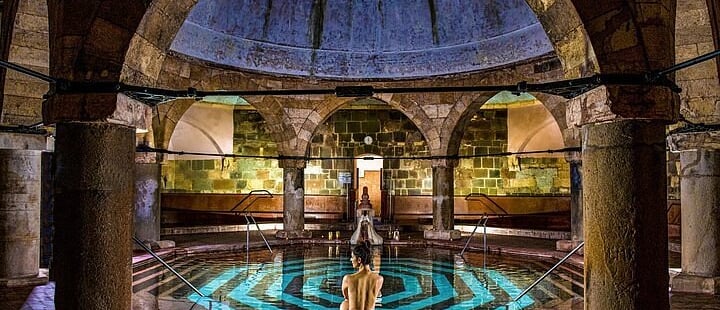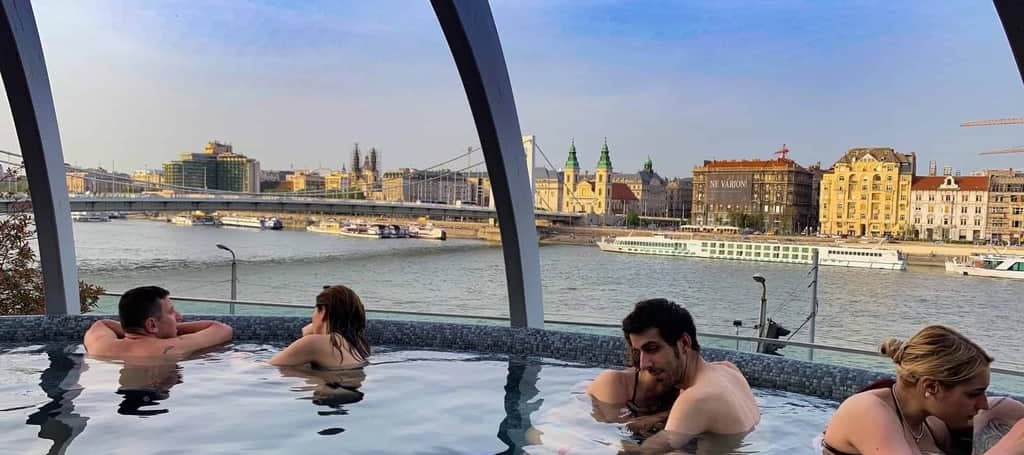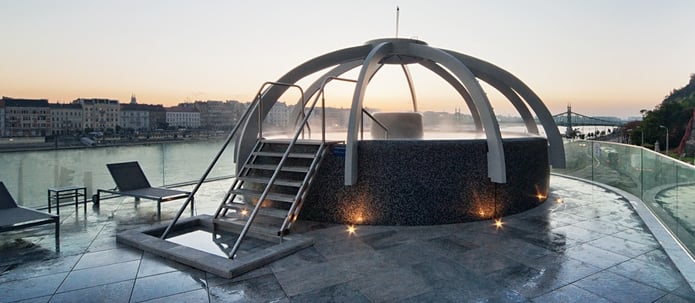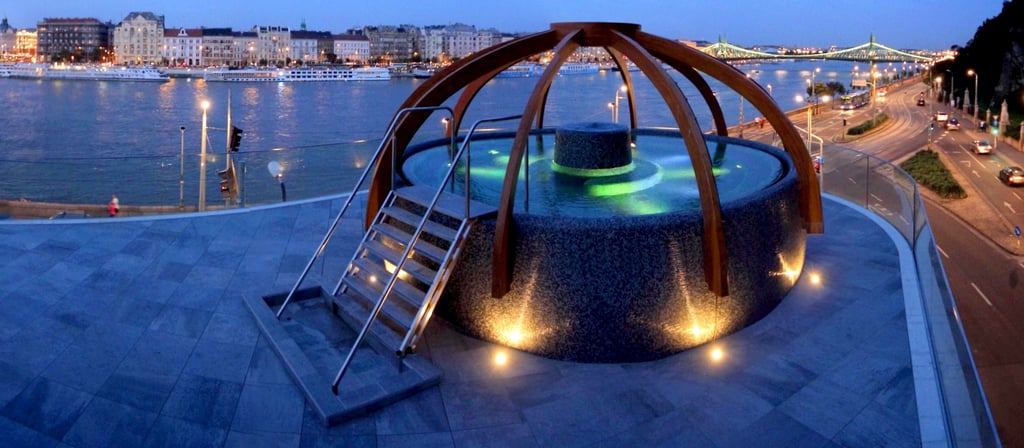Rudas Baths – Budapest
A timeless Ottoman thermal sanctuary where centuries of healing tradition meet modern relaxation under a domed Turkish cupola


A Living Ottoman Legacy on the Danube
Nestled on the Buda side of the Danube, beneath Gellért Hill, Rudas Baths stands as one of Budapest’s oldest surviving thermal complexes, a faithful embodiment of Ottoman-era architecture, mineral spring culture, spiritual ritual, thermal continuity, and urban heritage. Dating back to the late 16th century, the bath was constructed under Turkish rule as part of the Rudas Mosque complex. Its original octagonal cupola bath, with its central thermal pool and supporting arches, remains intact to this day. Visitors entering the interior may pause under a soaring domed ceiling punctured by a central oculus, through which sunlight dances upon rippling water and colored stone. This architectural heart is surrounded by corridor alcoves and warm side pools, structured to promote both communal bathing and individual contemplation. Over centuries, the bath has been expanded: classical side pools were added in the 19th century, and a modern wellness wing was built in the early 2000s. But what unites all eras is the reliance on the same healing springs—alkaline, calcium-rich, sulphate-laced thermal water drawn from subterranean aquifers. Rudas thus offers an immersive journey—where history, wellness tradition, and architectural drama converge beneath ancient arches.
The Cupola Pool: Thermal Water Under Mosaic Arches
The centerpiece of Rudas is its Turkish cupola pool, a virtually unchanged relic of original conception. Under a dramatic octagonal dome, eight columns support vaulted bays each holding a hot thermal basin with water temperatures around 42 °C. A central circular pool allows bathers to drift directly beneath the oculus, where sunlight, steam, and silence converge in atmospheric harmony. The layout invites ritualized entrance—visitors pass through marble-lined entryways, dip into hot water, and sit along mosaic benches, while tiled niches hold cast iron spouts emerging water onto waiting shoulders. The atmosphere is dim, hushed, spiritual, yet communal. It is the space where healing waters, Ottoman-era design, sensory memory, temporal resonance, and calm transcendence combine. Seasonal changes—such as morning sun shafts or evening lamplights—alter the emotional tone of the interior, yet the pool remains a constant focal point for health and quiet repose.
Around the cupola are cooling basins and cold-water plunge pools used for contrast therapy, offering both refreshing shock and renewed circulation. Courtyards connected to the historic pool provide spaces for seasonal sunbathing. The bath’s restored condition retains original stonework, carved arabesques, and patterned tile inlays. Modern additions—such as glass barriers, skylights, and subdued LED lighting—enhance the experience while respecting architectural integrity. Spa staff in traditional Turkish bath robes escort guests through bathing stages: sauna, steam room, washdown, hot pool, then cooler plunge, repeating cycles as desired. The cupola pool remains the soul of the ritual, its structural elegance and mineral potency offering genius loci, age-old therapy, immersive quiet, timed pace, and emotional focus.
Cultural Context and Historical Continuity
Rudas Baths form part of a chain of historic spa institutions that reveal Budapest’s layered cultural identity—from Ottoman rule to Habsburg grandeur, through 19th-century expansion and contemporary revitalization. Located at the foot of Gellért Hill, the bath connects physically to the city’s ancient spa culture. It embodies practical tradition: residents have bathed here to relieve arthritis or joint issues for centuries. But it also serves as a symbol of architectural preservation. During Communist times, Rudas continued operating but in a neglected state, its mosaic marred and upkeep minimal. Its eventual restoration restored not just stonework, but civic relevance, drawing new generations into thermal ritual. Today, the bath is featured in architectural tours, tourist guides, literary references, and product photography. It remains one of the few Ottoman structures still in active use, linking Budapest’s thermal identity to history. Visiting Rudas is part of grasping the city’s layered identity: Cultural continuity, thermal tradition, urban resilience, heritage preservation, and sacred architecture.
Wellness, Medical Baths, and Treatment Services
Rudas Bath offers optional therapeutic treatments alongside public bathing: medical spa services, including underwater traction, electrotherapy, targeted massage, and mud wraps. Guests may book physiotherapy packages—often under Hungarian medical prescriptions—or opt for wellness-enhancing services like lymphatic massage or reflexology. These treatments unfold in private rooms decorated with tile and soft backlighting, while staff use locally sourced bath minerals or herbal preparations. While the bath is more commonly visited for soak-and-sauna ritual, these health services provide a deeper clinic-level wellness dimension. Guests emerge feeling the synergy of centuries-old mineral efficacy and modern treatment methodology. Privacy areas reinforce calm presence. The bath also offers gender-segregated nights: notably early-week women-only sessions in the cupola pool and Jacuzzi area, encouraging cultural adaptability and restorative solitude. This approach expands inclusivity without diluting architectural beauty. The comprehensive offerings deliver therapeutic assistance, medical application, gender-focused schedule, private immersion, and modern wellness marriage to historic fabric.
Practical Information
Rudas Baths are located at Rudas Gyógyfürdő, Döbrentei tér 9, 1013 Budapest. Opening hours typically run from 6:00 AM to 10:00 PM, with shorter weekend schedules. Entry pricing varies based on time of day and type of pool access (including rooftop area and cupola pool). Gender-segregated and mixed-gender evenings alternate; towels and swim caps may be required. The bath is accessible via metro line M2 to Fővám tér or by tram on the Danube riverside. Visitors may rent towels and swimwear or bring their own. Medical treatment services require advance booking. Sauna world and rooftop access often carry extra charges. The facility features separate male, female, and mixed changing rooms, as well as wheelchair-accessible options. Visitors should bring suitable swimwear, be aware of spa etiquette (quiet zones, slippers, robe use), and avoid shows of public intoxication. Weekend evenings can be busy and ticketed. For maximum comfort, visit during weekday morning or early afternoon. Lockers require a refundable deposit token. On-site café offers refreshments. Phones and cameras are relaxed in certain areas but discouraged in the main pool for privacy.
Official Links
For ticket info, treatment booking, opening hours, and spa updates, visit:
https://rudasfurdo.hu/
Follow their updates and imagery on social media:
Instagram: rudas_gyogyfurdo_budapest
Facebook: Rudas Thermal Bath Budapest


Extensions, Saunas, and Panoramic Therapy Pools
In the early 21st century, Rudas expanded to include a modern wellness wing offering rooftop swimming and panoramic thermal pools. Located on the seventh floor, the heated open-air pool provides sweeping views across the Danube toward Pest and the Castle District, water heated to around 36 °C even in winter. Visitors may ascend from historic pools via elevator to the rooftop terrace, which also houses a beer-resting pool at 8°C—inviting thermal contrast therapy beneath open sky. Adjacent to the rooftop are Finnish and infrared saunas, steam rooms, wellness lounges, and massage studios offering Turkish massage and classical therapies. These contemporary amenities integrate ancient healing with 21st-century leisure: river panoramas, heated rooftop immersion, cold plunge variety, sauna rituals, and adults-only ticketed sessions (occasionally women-only and mixed-gender evenings). The juxtaposition of old and new—for example stepping from marble corridors into sauna rooms with floor-to-ceiling glass walls—blends ritualistic tradition with spa-day comfort, allowing each guest to curate an individual wellness sequence that spans centuries of bathing culture.
The Visitor’s Journey: Ritual, Flow, and Atmosphere
Visiting Rudas is as much emotional choreography as a spa day. Guests begin by purchasing tickets and often slip into traditional Turkish bath robes and slippers. The first descent into the cupola pool evokes a feeling of entering another world—dim lighting, warm stone underfoot, quiet voices, and rising vapor. After soaking, bathers may transition through steam rooms, cold plunge pools, and side alcove jets. Towels and bath chairs line the perimeter, offering rest in between dips. Later, guests may ascend to the wellness level, alternating sun-drenched floating with sauna and massage. Crowds are mixed: early-morning rituals invite locals seeking therapy, midday floods in tourists and young professionals, while late afternoons grow quieter again. The sensory palette—earthy stone, warm water, mild sulfuric scent, quiet chatter—remains consistent. Staff at Rudas operate with both Turkish hospitality flair and Hungarian order; changing rooms are monitored, saunas timed, water refreshed, while the architecture fosters self-guided retreat. Every step feels designed: from changing alcoves to mosaic floors to steam chambers, the movement flows like a healing narrative rather than mere leisure.






Rudas Baths received the Excellence Award Distinction for its historic architecture, authentic therapeutic tradition, seamless restoration, and immersive spa experience. It is worth the trip not only for its breathtaking domed pool and riverside location, but for offering a deeply resonant journey through centuries of wellness culture under one ancient cupola—where healing, architecture, and ritual harmonize in a uniquely Budapest setting.






